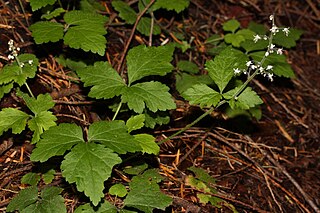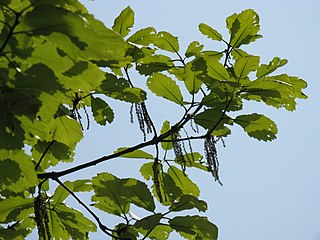
Hepatica is a genus of herbaceous perennials in the buttercup family, native to central and northern Europe, Asia and eastern North America. Some botanists include Hepatica within a wider interpretation of Anemone.

Clintonia is a genus of flowering plants in the lily family Liliaceae. Plants of the genus are distributed across the temperate regions of North America and eastern Asia, in the mesic understory of deciduous or coniferous forests. The genus, first described by Constantine Samuel Rafinesque in 1818, was named for DeWitt Clinton (1769–1828), a naturalist and politician from the U.S. state of New York. For this reason, plants of the genus are commonly known as Clinton's lily. The common name bluebead refer to the distinctive fruit of members of the genus. Since fruit color varies somewhat across species, the common name bead lily is used as well.

Ulmus davidiana var. japonica, the Japanese elm, is one of the larger and more graceful Asiatic elms, endemic to much of continental northeast Asia and Japan, where it grows in swamp forest on young alluvial soils, although much of this habitat has now been lost to intensive rice cultivation.

Hemerocallis fulva, the orange day-lily, tawny daylily, corn lily, tiger daylily, fulvous daylily, ditch lily or Fourth of July lily, is a species of daylily native to Asia. It is very widely grown as an ornamental plant in temperate climates for its showy flowers and ease of cultivation. It is not a true lily in the genus Lilium, but gets its common name from the superficial similarity of its flowers to Lilium and from the fact that each flower lasts only one day.

Hemerocallis middendorffii, known as Amur daylily, is a plant species in the subfamily Hemerocallidoideae of the family Asphodelaceae of the order Asparagales. It is native to the Russian Far East, northwest China, Korea, and Japan. It grows in meadows, mountain slopes, open woods, and scrub. It is cultivated in Asia for its edible flowers.
Ulmus bergmanniana var. lasiophyllaC. K. Schneid. is endemic to China, on mountain slopes at elevations of 2100–2900 m in Gansu, Shaanxi, north-west Sichuan, south-east Xizang, and north-west Yunnan.

Tiarella trifoliata, the three-leaf foamflower, is a species of flowering plant in the family Saxifragaceae. The specific name trifoliata means "having three leaflets", a characteristic of two of the three recognized varieties. Also known as the laceflower or sugar-scoop, the species is found in shaded, moist woods in western North America.

The genus Arachnis, abbreviated as Arach in horticultural trade, is a member of the orchid family (Orchidaceae), consisting of more than 20 species native to China, India, Southeast Asia, Indonesia, the Philippines, New Guinea, and the Solomon Islands.

Kalanchoe fedtschenkoi, formerly known as Bryophyllum fedtschenkoi, native to Madagascar, is widely sold as a house or garden plant that has established itself in the wild in some southern parts of the United States of America. Its specific epithet fedtschenkoi honors botanist Boris Fedtschenko (1873-1947).

Quercus aliena, the galcham oak or oriental white oak, is a species of oak in the family Fagaceae, in the white oak section Quercus.

Paris polyphylla is an Asian species of flowering plant native to China, the Indian Subcontinent, and Indochina. It produces spider-like flowers that throw out long, thread-like, yellowish green petals throughout most of the warm summer months and into the autumn. In the fall, the flowers are followed by small, scarlet berries. It is a perennial, which slowly spreads, is fully hardy in Britain, and survives in leafy, moist soil in either complete or partial shade.

Kalanchoe millotii is a succulent plant that is native south-central and southeastern Madagascar. It forms a shrub up to a foot high. The leaf is a hazy green and scalloped, with dense felt covering it.

Orostachys is a genus of the succulent family Crassulaceae that contains about 15 species. It is a biennial herb growing in China, Japan, Kazakhstan, Korea, Mongolia, Russia. Eight species occur in China.

Rhododendron eudoxum is a species of flowering plant in the Ericaceae family. It is native to the bamboo forests of southeast Xizang and northwest Yunnan, China, where it grows at altitudes of 3,300–4,300 m (10,800–14,100 ft). It is a dwarf shrub that typically grows to 30–120 cm tall, with leathery leaves that are long-elliptic to oblong-obovate in shape, and 2.3–3 cm (0.9–1.2 in) long and 0.8–1.4 cm (0.3–0.6 in) wide. Its flowers are red. It is placed in section Ponticum.

Phyllanthus tenellus is a herbaceous plant in the leafflower family, Phyllanthaceae. It is commonly called Mascarene Island leaf flower as it is native to the Mascarene Islands. It is often a weed in flower beds, gardens, roadsides, and other disturbed areas.

Hypericum przewalskii, commonly called Przewalski's St. John's wort, is a flowering plant in Hypericumsect. Roscyna that is native to China.
Occurring as a shrub or as a tree, Daphniphyllum majus is a species in the family Daphniphyllaceae. It is found in Mainland Southeast Asia and Yunnan in Zhōngguó/China. Uses of the plant include fuel and smoking-material.

Bambusa textilis, also known as slender bamboo, clumping bamboo and weaver's bamboo, is a species of bamboo in the Poaceae (grasses) family that is native to China. The subspecies var. gracilis is heavily cultivated in Australia.
















